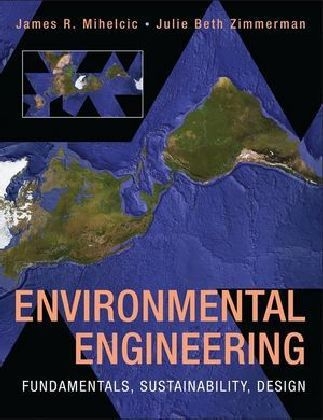
Environmental Engineering
John Wiley & Sons Ltd (Verlag)
978-0-470-16505-8 (ISBN)
- Titel ist leider vergriffen;
keine Neuauflage - Artikel merken
Mihelcic and Zimmerman and their co-authors introduce the field of environmental engineering by engaging the reader in a comprehensive development of basic principles, as well as providing a strong focus on design for sustainability. The breadth of content and level of treatment is appropriate for civil and environmental engineers and practitioners of elated disciplines seeking a survey of the field. By grounding their approach on the elements of design, the authors instruct readers in how to use the tools of green engineering to design for sustainability and the future of our planet and its inhabitants.
Chapter One: Engineering and Sustainable and Development. 1.1 Background. 1.2 Defining Sustainability. 1.3 Issues That Will Affect Engineering Practice in the Future. 1.4 The Sustainability Revolution. Key Terms. Chapter One Problems. References. Chapter Two: Environmental Measurements. 2.1 Mass Concentration Units. 2.2 Volume/Volume and Mole/Mole Units. 2.3 Partial-Pressure Units. 2.4 Mole/Volume Units. 2.5 Other Types of Units. Key Terms. Chapter Two Problems. References. Chapter Three: Chemistry. 3.1 Approaches in Environmental Chemistry. 3.2 Activity and Concentration. 3.3 Reaction and Stoichiometry. 3.4 Thermodynamic Laws. 3.5 Volatilization. 3.6 Air-Water Equilibrium. 3.7 Acid-Base Chemistry. 3.8 Oxidation-Reduction. 3.9 Precipitation-Dissolution. 3.10 Adsorption, Absorption, and Sorption. 3.11 Kinetics. Key Terms. Chapter Three Problems. References. Chapter Four: Physical Processes. 4.1 Mass Balances. 4.2 Energy Balances. 4.3 Mass Transport Processes. Key Terms. Chapter Four Problems. References. Chapter Five: Biology. 5.1 Ecosystem Structure and Function. 5.2 Population Dynamics. 5.3 Energy Flow in Ecosystems. 5.4 Oxygen Demand: Biochemical, Chemical, and Theoretical. 5.5 Material Flow in Ecosystem. 5.6 Ecosystem Health and the Public Welfare. Key Terms. Chapter Five Problems. References. Chapter Six: Environmental Risk. 6.1 Risk and the Engineer. 6.2 Risk Perception. 6.3 Hazardous Waste and Toxic Chemicals. 6.4 Engineering Ethics and Risk. 6.5 Risk Assessment. 6.6 More Complicated Problems with at Least Two Exposure Routes. Key Terms. Chapter Six Problems. References. Chapter Seven: Green Engineering. 7.1 What Is "Green Engineering?" 7.2 Design. 7.3 Pollution Prevention, Design for Environment, Industrial Ecology, Sustainability. 7.4 Fundamental Concepts. 7.5 Measuring Sustainability. 7.6 Policies Driving Green Engineering and Sustainability. 7.7 Designing a Sustainable Future. Key Terms. Chapter Seven Problems. References. Chapter Eight: Water Quality . 8.1 Introduction. 8.2 River Water Quality. 8.3 Lake and Reservoir Water Quality. 8.4 Wetlands. 8.5 Low-Impact Development. 8.6 Groundwater Quality. Key Terms. Chapter Eight Problems. References. Chapter Nine: Water Supply, Distribution, and Wastewater Collection. 9.1 Introduction. 9.2 Water Availability. 9.3 Water Usage. 9.4 Municipal Water Demand. 9.5 Water Distribution and Wastewater Collection Systems. Key Terms. Chapter Nine Problems. References. Chapter Ten: Water Treatment. 10.1 Introduction. 10.2 Characteristics of Untreated Water. 10.3 Water Quality Standards. 10.4 Overview of Water Treatment Processes. 10.5 Coagulation and Flocculation. 10.6 Hardness Removal. 10.7 Sedimentation. 10.8 Filtration. 10.9 Disinfection. 10.10 Membrane Processes. 10.11 Adsorption. 10.12 Energy Usage. Key Terms. Chapter Ten Problems. References. Chapter Eleven: Wastewater Treatment. 11.1 Introduction. 11.2 Characteristics of Domestic Wastewater. 11.3 Overview of Treatment Processes. 11.4 Preliminary Treatment. 11.5 Primary Treatment. 11.6 Secondary Treatment. 11.7 Modifications to the Activated-Sludge Process. 11.8 Attached-Growth Reactors. 11.9 Removal of Nutrients: Nitrogen and Phosphorus. 11.10 Disinfection and Aeration. 11.11 Sludge Treatment and Disposal. 11.12 Natural Treatment Systems. 11.13 Energy Usage during Wastewater. Key Terms. Chapter Eleven Problems. References. Chapter Twelve: Air Resources Engineering. 12.1 Introduction. 12.2 Human Health Impacts and Defenses. 12.3 Transport of Air. 12.4 Air Pollutants. 12.5 Emissions. 12.6 Control of Air Emissions. 12.7 Gaseous Emission-Control Technologies. 12.8 Particulate Emission-Control Technologies. Key Terms. Chapter Twelve Problems. References. Chapter Thirteen: Solid-Waste Management. 13.1 Introduction. 13.2 Solid-Waste Characterization. 13.3 Components of Solid-Waste Systems. 13.4 Management Concepts. Key Terms. Chapter Thirteen Problems. References. Chapter Fourteen: Built Environment. 14.1 Introduction. 14.2 Context-Sensitive Design. 14.3 Buildings. 14.4 Materials. 14.5 End of Life: Deconstruction, Demolition, Disposal. 14.6 Rightsizing Buildings. 14.7 Energy Efficiency: Insulation, Infiltration, and Thermal Walls. 14.8 Mobility. 14.9 Urban Heat Island. 14.10 Urban Planning, Smart Growth, and Planned Communities. Key Terms. Chapter Fourteen Problems. References. Answers to Selected Problems. Chapter Opener Photo Credits. Index.
| Zusatzinfo | Illustrations, maps |
|---|---|
| Verlagsort | Chichester |
| Sprache | englisch |
| Maße | 205 x 258 mm |
| Gewicht | 1418 g |
| Einbandart | gebunden |
| Themenwelt | Technik ► Bauwesen |
| Technik ► Umwelttechnik / Biotechnologie | |
| ISBN-10 | 0-470-16505-7 / 0470165057 |
| ISBN-13 | 978-0-470-16505-8 / 9780470165058 |
| Zustand | Neuware |
| Informationen gemäß Produktsicherheitsverordnung (GPSR) | |
| Haben Sie eine Frage zum Produkt? |
aus dem Bereich



